There’s no disputing the value of a business blog. The challenge is keeping it up and keeping the quality high.
To help, I’ve compiled a list of 33 blog post ideas that are relatively easy to develop. They’ll give you a headstart on be high-value, high-quality content without having to spend a lot of time creating them.
Keep in mind, value doesn’t always mean long. You only need to provide useful information that answers questions and helps your readers succeed.
Quick and Easy Blog Post Ideas that Get Results
Behind-the-scenes look at your business
Have you won an award or been recognized? Are you starting or ending a service? Do you have a company retreat coming up? All these things are newsworthy.
But you don’t have to limit yourself to news. I’m doing a daily video challenge, where I share my #solopreneurlife with my followers. Letting people see what goes on in the office, behind the curtain, can humanize your brand and build a fan base.
How I do [some task related to your area of expertise]
Thought leadership is about guiding your customers (and wider industry). If there’s a challenge that needs solving, take the lead. Test ways to overcome that challenge, and then share your process in a blog post.
Create a step-by-step guide. Optimize it for search. You may end up on page one of the SERPs.
How I [get some outcome your customers want]
This is a great way to create top-of-funnel content that drives interest in your product. You already know what your customers are trying to achieve. Explain how that outcome can be achieved.
By the way, you don’t have to promote your product in the article. But you can mention it. You can also mention your customers (who get their success from using your product).
Kajabi does a good job of this. In this article, they mention a feature that they have, including a screenshot from their landing page, but they don’t actually mention Kajabi.
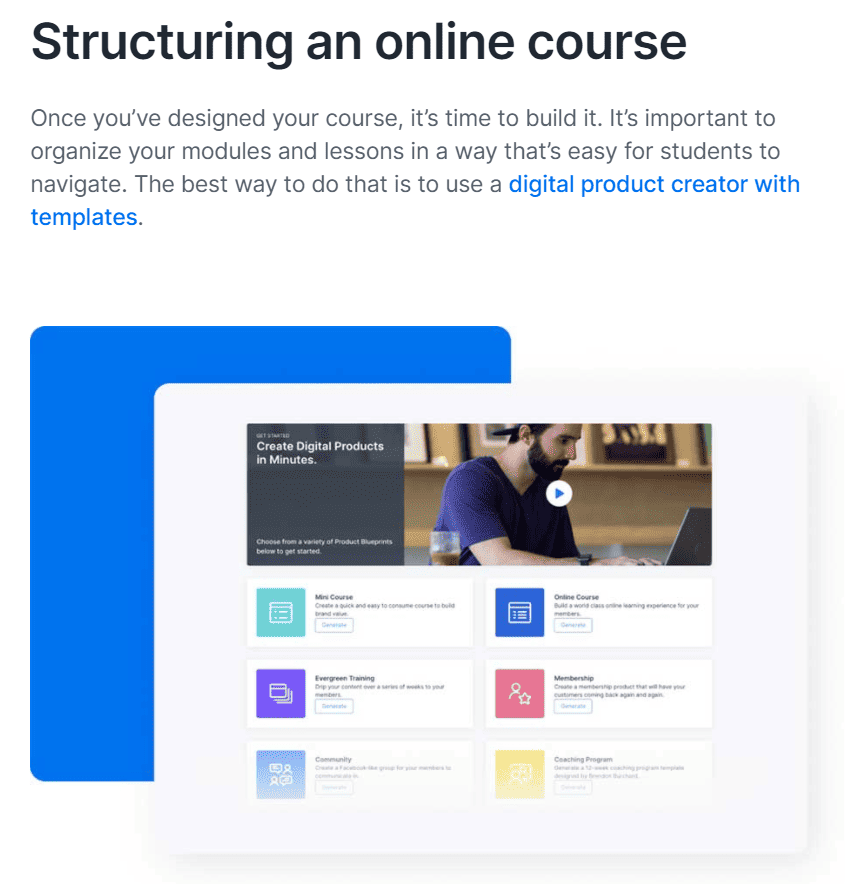
Answer a frequently asked question
Marcus Sheridan, more than a decade ago, was struggling to keep his pool business afloat. So he wrote down every question his prospects asked and wrote a blog post for each. As you might guess, those posts ranked well when anyone typed their question into Google.
Sheridan’s pool business blew up. And today, he’s a keynote speaker and uber-successful marketing consultant. Simply answering people’s questions is almost too obvious — but it works.
Discuss an issue brought up by a fan or customer
Take the same approach with issues your customers and fans struggle with. This is especially smart if your product point-blank solves that problem.
Identify a trend and share your thoughts
What are people in your industry talking about? What are the conversations taking place on social media? Bring those conversations to your blog, and add your own spin.
- What’s your take on the topic?
- How are you approaching it?
- What are people forgetting to think about?
Respond to someone else’s comment/idea
Is someone taking a wrong turn when talking about industry trends? Has someone put out a solution that’s going to make things worse, not better? This could be any idea: from a blog post, a presentation, a social media thread, or a book.
As a thought leader, it’s your job to call it out. Share the idea, what’s wrong with it, and the right way to approach it.
Ask one of your own burning questions
Maybe there’s a question you’ve been asking for a while. Especially if it affects all the players in your industry, it’s worth writing about.
And by the way, you don’t have to have the answer to write about it. Share your thoughts and invite people to join the discussion.
Review a book
If you’ve read a book that would be useful to your customers, or worse, isn’t worth the time it takes to turn the page, do a book review. Pull out the interesting ideas. Give your professional opinion.
Make a video in which you share a quick tip
You know, video is content too. And for some business blogs, video is the primary format. Jeff Walker’s blog is a good example:
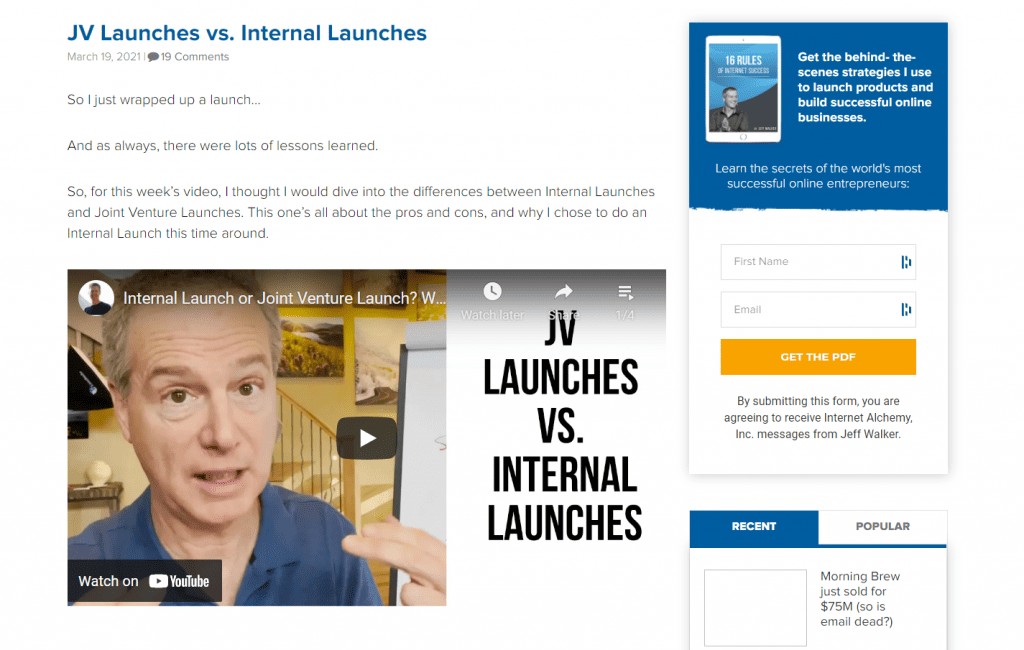
If video content is easier to create, grab your phone and start recording. It’s a fantastic format for every type of business.
Create a list of your favorite [resources, books or tools]
This is one of my favorite types of posts, because everyone loves a good list — and everyone wants to be included on your list.
This post I wrote for Mailshake is a good example:
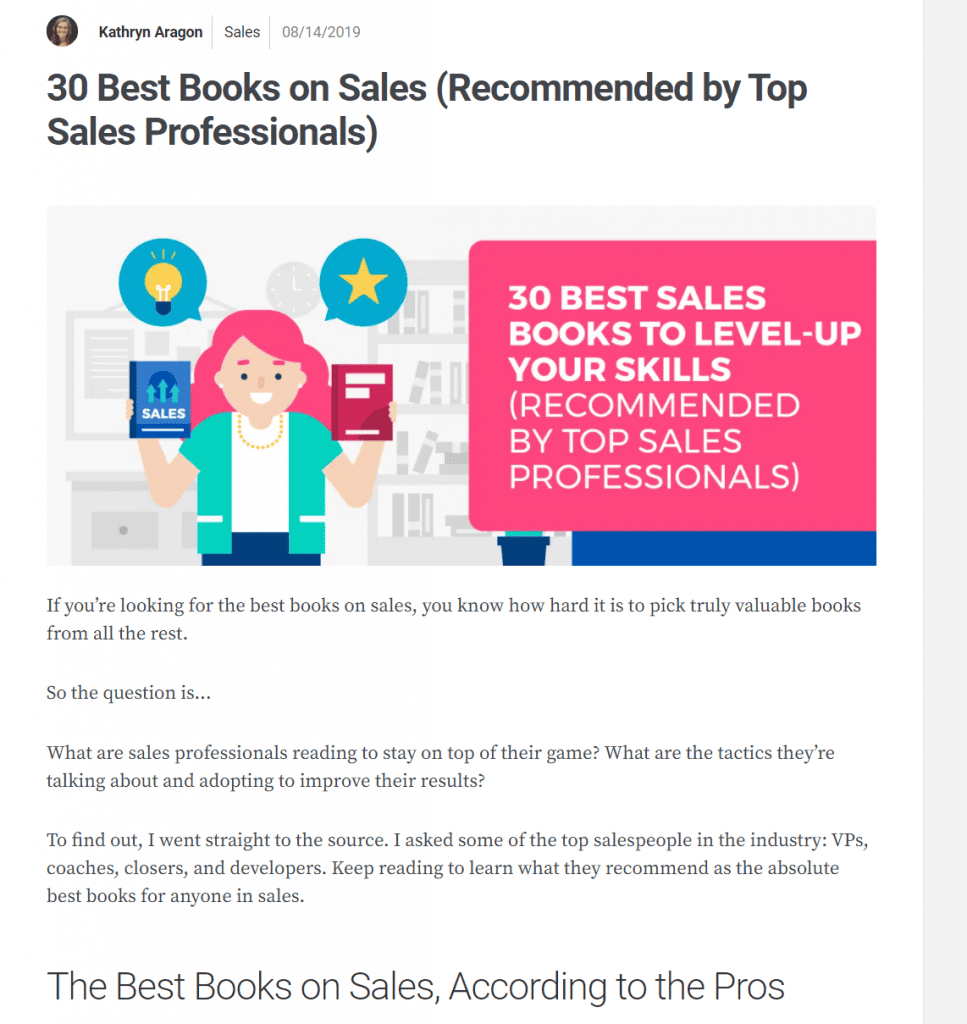
Here’s how I did it: I posted one time in LinkedIn, asking salespeople what their favorite books were. Then I rounded up the answers in an article.
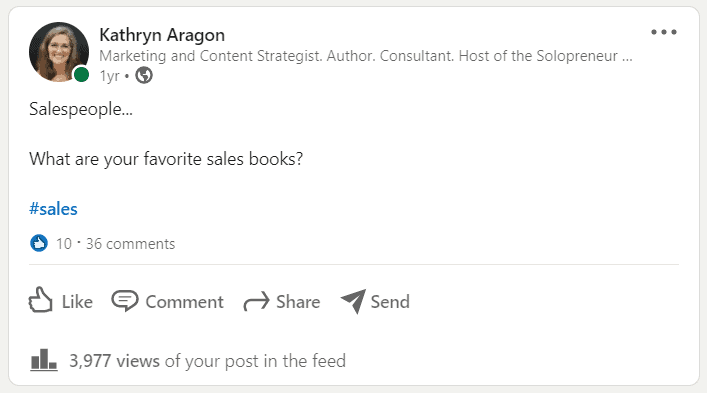
Create a list of the worst [resources, books or tools]
I don’t love this idea because it doesn’t fit my personality. But if you’re a contrarian, you can take things to the other extreme: what are the things people should avoid at all costs?
But don’t leave it there. Tell them what they should do as well.
Share quotes from influencers in your field
Do you have a favorite quote? You can write an entire post about that one quote, or you could do a roundup of great quotes related to your core topic.
NOTE: “[Your topic] quotes” is usually a strong keyword. Optimize this one for search.
Turn an old list into a presentation or video
Technology makes advanced content a breeze to create. If you’ve got a list post that’s performing well, use Visme to turn it into a presentation. Add a voiceover, and you’ve got a video.
Add your video to the top of the article, and it will almost certainly rise in the SERPs. Multimedia works!
NOTE: Visme is, hands down, the best tool for creating engaging presentations. Read my review here.
Make an infographic
Another way to add value to a post is to create an infographic. If your content is dry, numbers-heavy, or difficult to understand, consider showing rather than just telling. It can make your article stand out.
This post has an infographic on 28 Boring Words and What to Use Instead. The infographic is much more engaging than a list of boring words.
Don’t worry if you’re not a designer. Visme and Canva give you lots of templates that make it easy to create beautiful infographics.
Compile data from a study or presentation
This isn’t exactly easy, but it’s impressively authoritative. Do a survey. Gather the data. Put together a report. Then write a blog post about your findings.
Oh, and while you’re at it, create a video and an infographic of your findings. You’ll get backlinks, shares, and word-of-mouth exposure.
Share industry news
GDPR turned email marketing upside down. It was important news that companies needed to know about and understand. The brands that read the legalese, restated it in layman’s terms, and explained what to do about it were the winners.
Be the brand that shares this type of information.
Make a prediction
Similarly, if you see a trend, don’t just report on it. Make a prediction.
Based on your industry knowledge, the trends, rumors, and discussions with your peers, what should your customers be thinking about? Let them know in a prediction post.
Create a “Look Over My Shoulder” video
How-to content is always in high demand. But sometimes it’s easier to let people watch you do it. Instead of trying to break your process into steps and then write a long articles, turn on your camera and talk them through it.
Interview someone who’s doing something unique
This works especially well if that someone is a customer. How are they using your product? How are they leveraging your features?
Interview an expert in your field
Feature thought leaders, people on your staff, and authors. Create joint ventures and partnerships, and tell one another’s stories.
Do a case study
You need case studies anyway. You’re probably talking about your best clients anyway. Interview your customers and create a collection of case stories that prove your solutions work.
Talk about a mistake being made in your industry
What’s a “best practice” that doesn’t work. Maybe it used to work. Maybe it never worked. Explain the misconception and how your readers can avoid that mistake.
Bonus points if your product can help them avoid that mistake.
The best/worst advice you’ve ever heard
In the same line of thinking, what’s a piece of advice that made a difference in your life, career, business, or product? Did it help or hurt? How or why?
What you’d do differently if you had it to do again
Retrospectives are always an interesting read. It’s a combination of story, think piece, and advice. Told right, it can go viral. For this type of post, focus on the details.
If you’re brave enough, do this as a video.
Why you made a specific decision
Just four months after subscribing to Justin Goff’s newsletter, I got an email announcing that he was shutting it down. His “why” ended up being two articles on his blog, and a very interesting read.
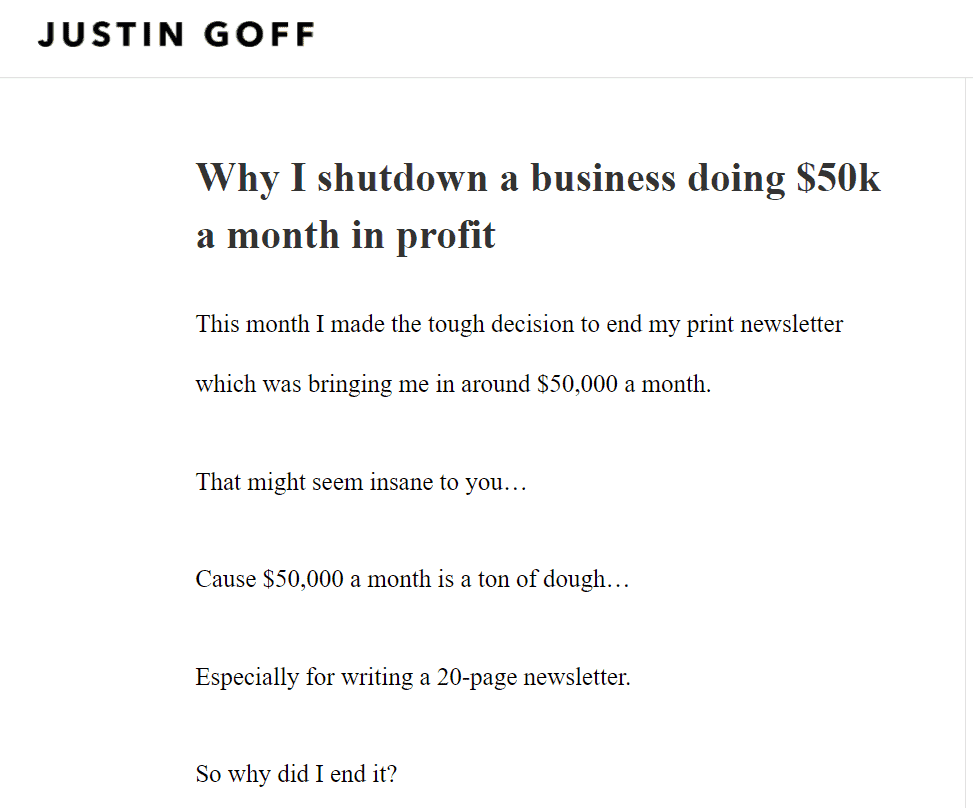
Any time you make a significant change to your business, people will wonder what’s going on. Go ahead and tell them. It’s easy content to create, and it answers people’s questions in advance.
Your best advice, summarized
If one of your customers asked to sit down over a drink and pick your brain, what would you tell them? Don’t save it for those quiet moments. Put it into an article or video and publish it.
Share an inspiring story
One of the best episodes of my Authority Journey podcast was the story of a man, paralyzed by a 6-inch tumor in his spinal cord. I told his story and shared my thoughts on what it takes to overcome.
Look for stories related to your business or product. Then use them liberally in your content. For your best stories, look to your partners, team members, and customers.
Share something from your personal life
Especially if your brand is personality driven, you can pull snippets from your personal life. The idea here isn’t to share every detail of your life. It’s to share your likes and dislikes, to be human and relatable.
So don’t shy away from your passion for baseball or Star Trek. Mention the movie you just saw or the challenges of homeschooling while working.
Compile the best blog posts or studies related to a specific topic
This type of article can rank well in search engines, if it’s comprehensive and well organized. For this type of post, focus on your research. Find the information people are searching for, and curate it in one article.

Lessons learned
Don’t be afraid to share your successes and your failures. It helps other people navigate your same path with confidence. It also ensures they think of you when they’re trying to figure something out.
Takeaways from an industry event or study
Hubspot is a master of this. They pull the best statistics or know-how together and organize it into a single point of reference for that information.

Back to You
Business blog posts need to related to your business. The blog is a marketing channel, after all. But it’s a channel that should engage, inform, and educate. Ideally, it will generate fans as well as leads and customers.
Use these ideas as inspiration. There’s no limit to the blog post ideas that will work for you.


